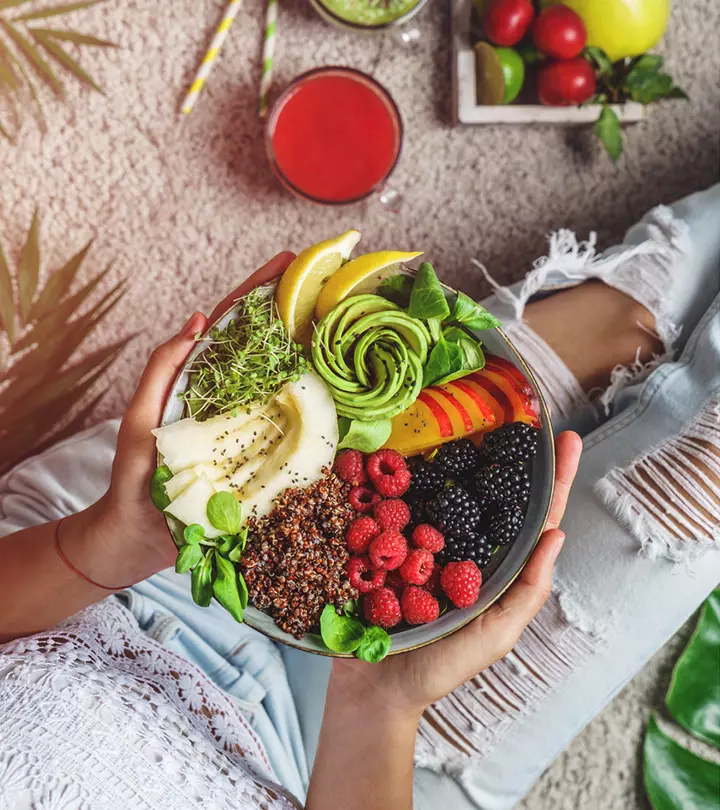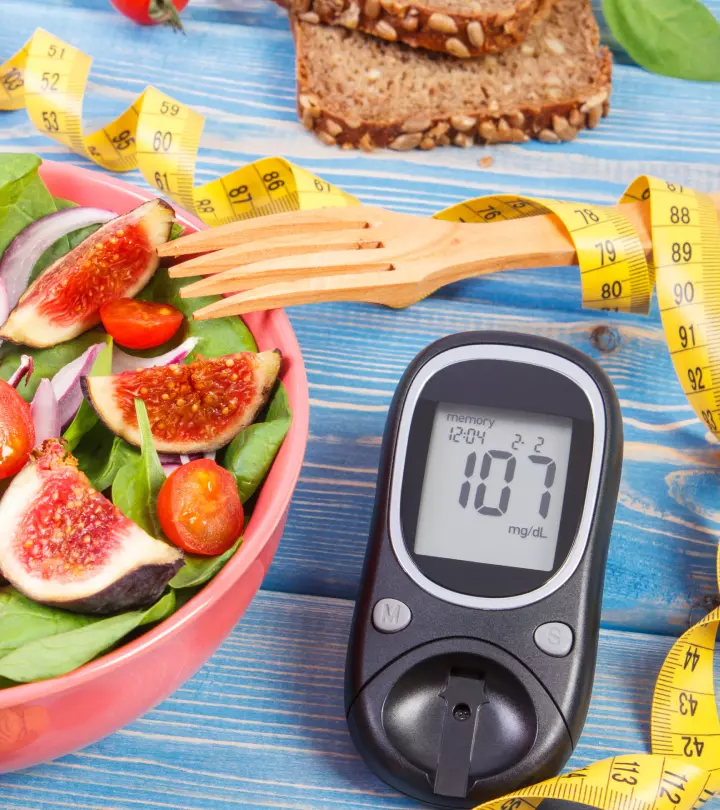AIP (Auto Immune Protocol) Diet – Foods To Eat & Avoid
A diet that is the key to gaining control over your autoimmune disease.

Image: Shutterstock
Autoimmune diseasesi Autoimmune diseases are conditions in which the immune system mistakenly attacks healthy tissues and cells in the body. affects about 8-10% of the world’s population (1). Other than underlying genetic factors, an unhealthy lifestyle and a lack of a nutrient-rich diet may trigger chronic inflammatory responses. The increased intake of packaged and processed food can worsen them further as they lack the essential nutrients required to maintain a healthy immune system (2).
However, symptomatic inflammation can be managed to some extent with an anti-inflammatory diet such as an autoimmune protocol (AIP) diet (3). It involves increasing the intake of antioxidant-rich and non-inflammatory foods that help reduce oxidative stress and other markers of inflammation (4). The diet also emphasizes consuming gut-friendly foods that help promote a healthy gut microbiome and reduce inflammation. While the exact mechanism of how the diet may work is still unclear and requires further research, its efficacy in easing the symptoms of autoimmune disease makes it worth trying (5). Scroll down to read more about the autoimmune diet, its benefits, and some lip-smacking recipes.
 At A Glance: AIP Diet
At A Glance: AIP Diet- Principle: Eliminating inflammatory and potential trigger foods to support autoimmune disease management and reduce inflammation.
- Purpose: To ease autoimmune symptoms and reduce inflammation through a carefully curated, nutrient-rich eating plan.
- Who It Is For: Individuals with auto-immune disease and inflammatory disorders.
- Duration: 30-90 days
- Who Should Avoid: Those who have severe weakness or serious illness should avoid it as this diet can be too restrictive.
- Cons: It can lead to nutrient deficiencies if not followed properly.
In This Article
What Is The AIP Diet?

It is an elimination diet and excludes all processed foods, such as grains, dairy, legumes, salt, and oils, that may weaken the immune system which is already compromised due to the body’s autoimmune response (5). The goal of the AIP diet is to ease symptoms of autoimmune conditions and improve the quality of life of the patient. Additionally, it is a therapeutic process that also involves promoting healthy sleep habits, and stress management, along with consuming nutrient-dense foods.
 Pro Tip
Pro TipThe autoimmune protocol diet (AIP) is very similar to but more restrictive than the paleolithic (paleo) diet — a primitive diet eaten by our prehistoric ancestors (6). It is best for people who have chronic autoimmune conditions like type 1 diabetes, rheumatoid arthritis, and inflammatory bowel disease (IBD). Keep reading to understand the way it works.
Key Takeaways
- The AIP Diet is a strict diet aimed at managing autoimmune diseases by eliminating inflammatory foods.
- It consists of three phases: elimination, maintenance, and reintroduction, to help identify triggers and alleviate symptoms.
- It may help improve gut health, symptom relief, and better blood sugar control.
- It can be challenging and may not provide permanent relief, so consulting a healthcare professional is advised.
How Does The Autoimmune Protocol Diet Work?
The autoimmune protocol diet works by ruling out all the pro-inflammatory foods that may trigger or worsen autoimmune diseases or their symptoms. It may help relieve symptoms such as joint pain, fever, swelling, digestive issues, and recurring sickness to a certain extent.
AIP diet follows a systematic process to allow your body to smoothly shift to the new diet and heal itself. There are three main phases of the AIP diet (5).
- Phase 1: Elimination
In this phase, start excluding food groups gradually. You may start with one or two food groups. For example, eliminate gluten-rich foods in week one and dairy products in week two. In week three, exclude grains and so on. This phase lasts up to 6 weeks.
- Phase 2: Maintenance/Elimination Continued
This is the extension of the first phase. You may continue with the elimination process if required. Continue it for 5 weeks after phase one.
- Phase 3: Reintroduction
It involves slowly reintroducing a food group that was eliminated during the first two phases. Assess the symptoms to see how the body responds. If the food does not cause side effects even after gradually increasing the portion, reintroduce it into your diet.
The process of removing and re-adding food groups might seem slow, but it results in many health benefits, and we will explore that in the next section.
Benefits Of The AIP Diet
As the cause of the inflammation is eliminated, your body gets time to heal itself. This may lead to the following health improvements:
1. May Provide Relief In Gut Disorders
A study published in the journal Crohn’s & Colitis 360 concluded that following the AIP diet may help ease the symptoms of irritable bowel disease (IBD) such as diarrhea and abdominal pain (7). The results may start to show as early as around the third week of the elimination phase.
2. May Help Manage Hashimoto’s Thyroiditis
Dietary intervention may help reduce the level of inflammation and improve the quality of life of people with Hashimoto’s thyroiditis. While consuming anti-inflammatory foods may not impact thyroid function, following such diets may slow down the progress of thyroid damage and reduce oxidative stress (8), (9).
3. May Alleviate The Symptoms Of Rheumatoid Arthritis
AIP diet may help reduce the inflammation caused by rheumatoid arthritis. Consumption of gluten-free, low-fat, vegan, and anti-inflammatory diets may help manage symptoms such as pain and joint tenderness (10),(11). However, more studies are required to yield reliable results in this area.
4. May Manage Sugar Levels In Diabetes
AIP diet eliminates processed carbs and sugar and may help manage blood sugar levels and aid in weight loss for people with diabetes. A study published in the Journal of Restorative Medicine found that an anti-inflammatory diet could reduce inflammatory markers in the body, thus, reducing blood glucose and serum lipid (or fat) levels to some extent (12).
5. May Control Celiac Disease
The AIP diet eliminates all types of grains. Limiting gluten consumption may help manage the symptoms of celiac disease, such as bloating and gastrointestinal discomfort, and improve the quality of life (13).
 Did You Know?
Did You Know?Now that we have an idea about how the AIP diet may help you deal with the symptoms of autoimmune conditions let us explore the AIP diet food list.
AIP Diet: Foods To Eat

Here are some recommendations for AIP-friendly foods that you may consume to manage your body’s auto-immune response and inflammation. The following ingredients are included in the autoimmune paleo diet:
- Lean ground proteins, including turkey, chicken, and beef (14).
- Seafood, such as tuna and salmon (15).
- Vegetables such as broccoli, cabbage, mushrooms, turnips, zucchini, garlic, Brussels sprouts, and other cruciferous vegetablesi Vegetables like broccoli, cauliflower, cabbage, etc., with distinctive cross-shaped (cruciferous) flowers and various health benefits. like collard greens, daikon, horseradish, kale, kohlrabi, radish, turnips, and wasabi (16).
- Starchy vegetables such as sweet potatoes (17).
- Most fresh fruits, including apples, capers, chokeberries, and cranberries (18).
- Herbs such as lovage, dill, cilantro, and radish leaves (18).
- Fermented foods such as sauerkraut, kimchi, and coconut kefir (19).
- Olive oil (20).
The AIP diet excludes all foods that might aggravate inflammation or are potential allergens. Let us take a look at the ones that are eliminated from the diet.
AIP Diet: Foods to Avoid

There are a number of non-AIP-compliant foods that need to be avoided when on an AIP diet. These foods contain proteins and other organic compounds that may upset the gut and lead to inflammation:
- Nightshade vegetables such as all varieties of tomatoes, eggplant, potatoes, and peppers (21).
- Onions are high in FODMAPs so, you may want to avoid them in the IBS diet (22).
- Nuts and seeds (5)
- Dairy products (23)
- Red meat (23)
- All grains (5)
- Legumes and beans (legumes may be allowed in the second phase of the AIP diet) (5).
- Coffee and alcohol
- Refined sugars, processed trans fats, and salt (it is allowed only in moderation) (24).
Despite restrictions, you can still cook up sumptuous meals. Let us explore how you can plan your meals for this diet.
Sample AIP Diet Plan
Day 1
- Breakfast: 1 bowl of mixed berries smoothie (blueberries, strawberries, and blackberries). 2 slices of whole grain bread.
- Lunch: 3-4 ounces of ginger-lime salmon seasoned with veggies.
- Snack: 1 sliced cucumber, and a handful of almonds.
- Dinner: 1 bowl of instant pot chicken soup, ½ cup quinoa with 3-4 ounces of grilled chicken.
Day 2
- Breakfast: 3.5 ounces of sweet potato hash cooked with lean steak.
- Lunch: 2-3 ounces of sliced turkey breast with avocado, 1 cup of mixed vegetables.
- Snack: 1 ounce of a compliant beef jerky stick (ensure it contains no additives).
- Dinner: 3.5 ounces of oven-baked chicken thighs with roasted asparagus, ½ cup of brown rice.
Day 3
- Breakfast: ½ cup of oatmeal and 1 cup of spinach cooked in AIP-friendly fats.
- Lunch: 1 cup of crispy kale chips paired with 4-6 ounces of grilled chicken breast.
- Snack: 5 ounces of canned tuna in water.
- Dinner: 1 mushroom patty burger of 4-6 ounces served without the bun.
Day 4
- Breakfast: 1 cup of sautéed mushrooms and onions with 4-5 ounces of organic lean pork loin.
- Lunch: 1½ cups of creamy AIP-compliant chicken salad (use coconut milk-based dressing), one grain-free wrap.
- Snack: 6-8 slices of pickles without added sugars or non-compliant ingredients.
- Dinner: 1½ to 2 cups of mushroom soup, 1 cup of brown rice with 3-4 ounces of grilled chicken.
Day 5
- Breakfast: 4-6 ounces of sautéed chicken livers with 1 cup of wilted spinach.
- Lunch: 3-4 ounces of vegetable stir-fry with tofu and ½ cup of cooked quinoa.
- Snack: 1 stick of organic Italian-style beef jerky stick that adheres to AIP guidelines.
- Dinner: 3-4 ounces of roasted duck served with 1 cup of Brussels sprouts
Day 6
- Breakfast: 1 bowl of AIP-compliant porridge and 2 boiled eggs.
- Lunch: 4-5 sweet potato chicken poppers (12 ounces) made with AIP-approved ingredients, and 1 cup of mixed vegetables.
- Snack: 1 cup of fresh melon (ensure it’s ripe and free from added sweeteners).
- Dinner: 6-8 ounces of broiled salmon.
Day 7
- Breakfast: 12-16 ounces of blueberry coconut smoothie made with AIP-friendly ingredients, and ½ cup of oatmeal.
- Lunch: 4-6 ounces of grilled chicken tenders with a side of 1 cup of roasted asparagus
- Snack: 2 slices of sweet potato toast with 2 tablespoons of mashed avocado and spices
- Dinner: 1 bowl of instant pot chicken soup, 3-4 ounces of salmon with 1 cup of quinoa.
You can follow the above meal plans or tailor your own according to your preferences and health goals. Let us now explore the easy AIP recipes below to pour a taste into your healthy auto-immune protocol diet.
Easy AIP Diet Recipes

Breakfast Recipes For AIP Diet
1. Sweet Potato Breakfast BowlIngredients
- 1 medium sweet potato
- ¼ cup of coconut milk
- ¼ teaspoon of salt
- Toppings of your choice (coconut yogurt, blueberries, cinnamon, etc.)
How To Prepare
- Preheat the oven and bake the sweet potato for 10-15 minutes until they turn soft.
- Remove the peel and mash the sweet potato with coconut milk and salt.
- Add toppings and serve your breakfast bowl warm with a spoon.
2. Sausage And Seasoned Sweet PotatoIngredients
- 1 sweet potato, peeled and diced
- 2-3 AIP-compliant sausages or plain pork sausages
- 2 cups of AIP-friendly leafy greens (spinach or kale)
- 2 tablespoons of olive oil
- 1 teaspoon of dried herbs (thyme or rosemary)
How To Prepare
- Cook sausages in a skillet over medium heat until brown for about 5-7 minutes per side. Take them off.
- Cook sweet potatoes in the same skillet and add oil. Season with herbs. Cook until crispy for about 10-15 minutes.
- Add the greens and cook for about 2-3 minutes.
- Slice sausages into bite-sized pieces.
- Add the sausages with sweet potatoes and greens in the skillet. Stir together and cook for an additional 2-3 minutes to heat sausages through.
- Serve warm with a squeeze of lemon.
Lunch Recipes For AIP Diet
1. Lemony And Crispy BeefIngredients
- 2 pounds of grass-fed ground beef
- 2 teaspoons of coarse salt
- 1 tablespoon of garlic and ginger powder
- 2 tablespoons of olive oil (or lard for AIP)
- 1 large lemon
- A cup of green vegetables like spinach, cilantro, and kale.
How To Prepare
- Add olive oil or lard to the skillet on high heat and add ground beef to it. Stir till the beef is broken up and crumbly.
- Add salt and garlic ginger powder. Let it cook for 10 minutes, stirring occasionally.
- Cook the beef until the liquid evaporates and the beef turns dark brown.
- Saute the greens for about 3 minutes in a different pan and add to the cooked beef.
- Add a squeeze of fresh lemon and serve warm.
2. AIP Chicken And Veggie Stir-FryIngredients
- 1 boneless and skinless chicken breast (sliced)
- 1 cup of broccoli florets
- 1 cup of carrots (sliced)
- 2 tablespoons of olive oil
- 1 teaspoon of dried thyme or rosemary
- Salt to taste
- Cilantro for garnish
How To Prepare
- Heat olive oil in a frying pan and add the sliced chicken to the pan.
- Cook by stirring occasionally for about 5-7 minutes until the chicken is not pink from the middle.
- Add broccoli florets and sliced carrots to the pan and sprinkle dried herbs and a pinch of salt over them.
- Stir-fry for about 5-7 minutes until the vegetables turn crispy and golden brown.
- Garnish with finely chopped cilantro and serve.
Dinner Recipes For AIP Diet
1. Spinach And Garlic MeatballsIngredients
- 1 pound of ground beef (grass-fed)
- 1 cup of chopped spinach (fresh)
- 4 cloves of garlic (minced)
- Real salt to taste
- 4 carrots
- Bone broth (chicken preferably)
How To Prepare
- Chop the carrots into ½ -inch chunks. Add the carrots and bone broth to the Instant Pot.
- Mash the beef in a bowl and mix it with garlic, spinach, and salt until well combined.
- Make small meatballs and place them on top of the carrots.
- Now close the pressure cooker lid. Set the vent to ‘sealed.’
- Press ‘manual’ and set the time to 20 minutes.
- When the timer goes off, release the pressure, and your carrot garlic meatballs are ready.
2. Ginger-Lime SalmonIngredients
- 1½ pounds of salmon
- 1 bunch of green onions (green and white parts separated)
- ¼ cup of olive oil
- 2 inches of ginger (grated)
- 3 cloves of garlic (crushed)
- 1 tablespoon of lemon juice
- 1 teaspoon of lime zest
- 1 teaspoon of honey (raw and organic)
- ¼ teaspoon of sea salt
- 2 to 5 zucchini (sliced)
How To Prepare
- Preheat the oven to 375 degrees. Prepare veggies by placing silenced zucchini and green onion greens in a greased casserole dish.
- Add white onion parts, oil, lime juice, ginger, garlic, lime zest, honey, and sea salt in a blender. Whisk them until the onions are chopped but not pureed.
- Place the cold salmon filet on the veggies, pour the blended onion marinade over the salmon, and let it sit for 20 minutes.
- Bake the fish for 10-12 minutes. Avoid overcooking.
- Garnish it with lemon slices and green onion greens.
Soup Recipes For AIP Diet
1. Instant Pot Chicken Soup
- 1 onion diced
- 2 chopped carrots
- 1½ cups of chopped green beans
- 1 teaspoon of ginger-garlic paste
- 4 lb chicken
- 2 teaspoons of sea salt
- 5 cups of water
- Chopped cilantro for garnish
How To Prepare
- Put the onion, carrots, green beans, and garlic-ginger paste in the instant pot/electric pot.
- Lay the chicken over the vegetables and sprinkle with salt.
- Add water, close the lid, and set it to “soup” for 30 minutes.
- Take out the chicken, debone it, and shred the meat.
- Place the meat back in the instant pot and stir.
- Serve with chopped cilantro sprinkled on top.
2. Mushroom SoupIngredients
- Pastured bacon
- 1 yellow onion
- 5 garlic cloves
- 1 pound of mushrooms
- Dried herbs (thyme, rosemary, or parsley)
- 1 teaspoon of arrowroot powder
- Bone broth (preferably chicken)
- Sea salt (as per taste)
How To Prepare
- Cook your bacon until crispy and take them out leaving some grease in the pot.
- Saute onion in the same pot and add garlic, mushrooms, and dried herbs. Cook until mushrooms build flavor for about 5 minutes.
- Sprinkle arrowroot flour over the veggies to create a roux. Stir.
- Add broth and season with salt. Simmer for 15-20 minutes until thick.
- Garnish with bacon pieces and parsley, and treat your tastebuds.
With these AIP recipes, you can steer clear of inflammation and make your meals more interesting, however, this diet has its fair share of downsides which we have discussed in the following section.
Side Effects Of The AIP Diet

Since the AIP diet involves the strict elimination of a lot of pro-inflammatory food groups, it may lead to nutrient deficiency if AIP-compliant foods are not selected carefully. This can be harmful to health and the actual aim behind the AIP diet may backfire.
It can also pose various social challenges such as not being able to eat at a social gathering. This can push the person on this diet towards social isolation causing mental stress. Moreover, there is also no guarantee that following this diet will provide prolonged relief from autoimmune diseases.
The reintroduction phase can be confusing and is not recommended to do on your own. If the food reactions are not noted carefully it may get confusing and fail the hard work done over the past few weeks. Worse, it may lead to serious inflammation if the wrong food groups are reintroduced without proper interval. Therefore, it is advised to consult a registered dietician or a doctor if you have a diagnosed autoimmune condition. This may even aggravate the inflammation.
Infographic: Foods To Include In The AIP Diet
AIP or autoimmune protocol diet contains a list of safe foods that an individual with an autoimmune disease can eat. These foods do not raise inflammation levels and have a positive effect on the immune system. Explore the AIP-compliant diet food list in the infographic below to reset your gut.

Illustration: StyleCraze Design Team
The autoimmune protocol (AIP) diet is a great solution for individuals dealing with autoimmune diseases. Its primary focus lies on eliminating inflammatory foods and promoting nutrient-dense and healing options. In this way, it empowers individuals to take control of their health naturally. Although following the AIP diet can be very challenging, its numerous benefits such as improved gut health and reduced inflammation can make it worthwhile for many. However, it’s crucial to consult healthcare professionals and proceed with caution when on this diet. Since cases vary from patient to patient, it is recommended to follow the diet ingredients based on your own tolerance only. This extreme diet may also lead to nutrient deficiencies if not managed carefully. The reintroduction phase, in particular, requires careful monitoring. Nevertheless, with no possible cure in sight for autoimmune diseases, the AIP diet represents a ray of hope to many individuals.
Frequently Asked Questions
What fruits are AIP approved?
Fruits that are rich in antioxidant and anti-inflammatory properties are allowed in the AIP diet. This includes such as blackberries, raspberries, cranberries, black currants, blueberries, strawberries, grapes, apples, and sour cherries (25).
How long should I do the AIP diet?
You should follow an AIP diet for 4 to 8 weeks. It provides enough time to gradually eliminate the food groups and reset your gut.
Do people lose weight on AIP?
Yes, you may lose weight if you follow this diet, as clinical research shows that an anti-inflammatory diet or diet for autoimmune diseases may be highly effective in obesity management (26).
Why is coconut allowed on AIP?
Coconut is included in the diet because according to one study, it was found that lipids found in coconut oil may help reduce inflammation in the intestine (27).
Can I eat cucumbers on an AIP diet?
Yes, you can eat cucumbers on an AIP diet as they are easily digestible and do not lead to gut inflammation (28).
What spices should I avoid on AIP?
Overly spicy condiments such as red pepper should be avoided on the AIP diet as it has been shown to cause irritation in the gut and exacerbate inflammation (29).
Is rice allowed on the AIP diet?
Generally, the AIP diet does not include any grains, including rice. However, it may be allowed as per the individual case only under the guidance of the doctor. Research shows that rice is easily digestible and has low allergenicity and it may be consumed by people with functional gastrointestinal disorders (30).
Illustration: AIP (Auto Immune Protocol) Diet – Foods To Eat & Avoid
_diet_%E2%80%93_foods_to_eat__avoid_illustration.jpg.webp)
Image: Stable Diffusion/StyleCraze Design Team
The following video explains the efficacy of the AIP diet in managing Hashimoto’s disease. But here’s a catch – it is not for everyone. Watch the following video to learn more.
References
Articles on StyleCraze are backed by verified information from peer-reviewed and academic research papers, reputed organizations, research institutions, and medical associations to ensure accuracy and relevance. Read our editorial policy to learn more.
- Polyphenols in the treatment of autoimmune diseases
https://www.ncbi.nlm.nih.gov/pmc/articles/PMC6588481/#R4 - Role of “Western Diet” in Inflammatory Autoimmune Diseases
https://www.ncbi.nlm.nih.gov/pmc/articles/PMC4034518/ - Personalized Medicine in Autoimmune Diseases
https://www.ncbi.nlm.nih.gov/pmc/articles/PMC8618505/. - The treatment strategies of autoimmune disease may need a different approach from conventional protocol: A review
https://www.ncbi.nlm.nih.gov/pmc/articles/PMC3523489/ - Efficacy of the Autoimmune Protocol Diet for Inflammatory Bowel Disease
https://www.ncbi.nlm.nih.gov/pmc/articles/mid/NIHMS889275/ - The Paleolithic Diet
https://www.ncbi.nlm.nih.gov/pmc/articles/PMC9957574/ - An Autoimmune Protocol Diet Improves Patient-Reported Quality of Life in Inflammatory Bowel Disease
https://www.ncbi.nlm.nih.gov/pmc/articles/PMC6892563/ - Efficacy of the Autoimmune Protocol Diet as Part of a Multi-disciplinary Supported Lifestyle Intervention for Hashimoto’s Thyroiditis
https://www.ncbi.nlm.nih.gov/pmc/articles/PMC6592837/ - Nutritional Management of Thyroiditis of Hashimoto
https://www.ncbi.nlm.nih.gov/pmc/articles/PMC9101513/ - Nutrients foods and dietary patterns in the management of autoimmune rheumatic diseases
https://www.researchgate.net/publication/361405433_Nutrients_foods_and_dietary_patterns_in_the_management_of_autoimmune_rheumatic_diseases - Health effects of a low-inflammatory diet in adults with arthritis: a systematic review and meta-analysis
https://www.ncbi.nlm.nih.gov/pmc/articles/PMC7503186/ - Effect of the Anti-Inflammatory Diet in People with Diabetes and Pre-Diabetes: A Randomized Controlled Feeding Study
https://www.ncbi.nlm.nih.gov/pmc/articles/PMC6550471/ - Advances in Celiac Disease and Gluten-Free Diet
https://www.ncbi.nlm.nih.gov/pmc/articles/PMC8839834/ - The Role of Nutrition in Immune-Mediated Inflammatory Skin Disease: A Narrative Review
https://www.ncbi.nlm.nih.gov/pmc/articles/PMC8840467/ - Fatty fish consumption and risk of latent autoimmune diabetes in adults
https://www.ncbi.nlm.nih.gov/pmc/articles/PMC4216999/ - Glucosinolates From Cruciferous Vegetables and Their Potential Role in Chronic Disease: Investigating the Preclinical and Clinical Evidence
https://www.ncbi.nlm.nih.gov/pmc/articles/PMC8575925/ - Food and Food Groups in Inflammatory Bowel Disease (IBD): The Design of the Groningen Anti-Inflammatory Diet (GrAID)
https://www.ncbi.nlm.nih.gov/pmc/articles/PMC8064481/ - Potential Implications of Quercetin in Autoimmune Diseases
https://www.ncbi.nlm.nih.gov/pmc/articles/PMC8260830/ - Are Fermented Foods Effective against Inflammatory Diseases?
https://www.ncbi.nlm.nih.gov/pmc/articles/PMC9915096/ - Extra virgin olive oil: a key functional food for prevention of immune-inflammatory diseases
https://pubmed.ncbi.nlm.nih.gov/27783083/ - Nightshade Vegetables: A Dietary Trigger for Worsening Inflammatory Bowel Disease and Irritable Bowel Syndrome?
https://pubmed.ncbi.nlm.nih.gov/37202602/ - Irritable Bowel Syndrome
https://www.ncbi.nlm.nih.gov/books/NBK534810/. - Design of an anti-inflammatory diet (ITIS diet) for patients with rheumatoid arthritis
https://www.ncbi.nlm.nih.gov/pmc/articles/PMC6997513/ - How to Tackle the Relationship between Autoimmune Diseases and Diet: Well Begun Is Half-Done
https://www.ncbi.nlm.nih.gov/pmc/articles/PMC8620243/ - Active Compounds in Fruits and Inflammation in the Body
https://www.ncbi.nlm.nih.gov/pmc/articles/PMC9229651/ - The Efficacy of an Energy-Restricted Anti-Inflammatory Diet for the Management of Obesity in Younger Adults
https://www.ncbi.nlm.nih.gov/pmc/articles/PMC7700374/ - Impact of environmental and dietary factors on the course of inflammatory bowel disease
https://www.ncbi.nlm.nih.gov/pmc/articles/PMC3413052/ - Dietary practices and inflammatory bowel disease
https://www.ncbi.nlm.nih.gov/pmc/articles/PMC6153885/ - Consumption of spicy foods and the prevalence of irritable bowel syndrome
https://www.ncbi.nlm.nih.gov/pmc/articles/PMC3801318/ - Are Rice and Spicy Diet Good for Functional Gastrointestinal Disorders?
https://www.ncbi.nlm.nih.gov/pmc/articles/PMC2879848/
Read full bio of Mary Sabat
Read full bio of Himanshi Mahajan
Read full bio of Arshiya Syeda
Read full bio of Moksha Gandhi


























Community Experiences
Join the conversation and become a part of our empowering community! Share your stories, experiences, and insights to connect with other beauty, lifestyle, and health enthusiasts.